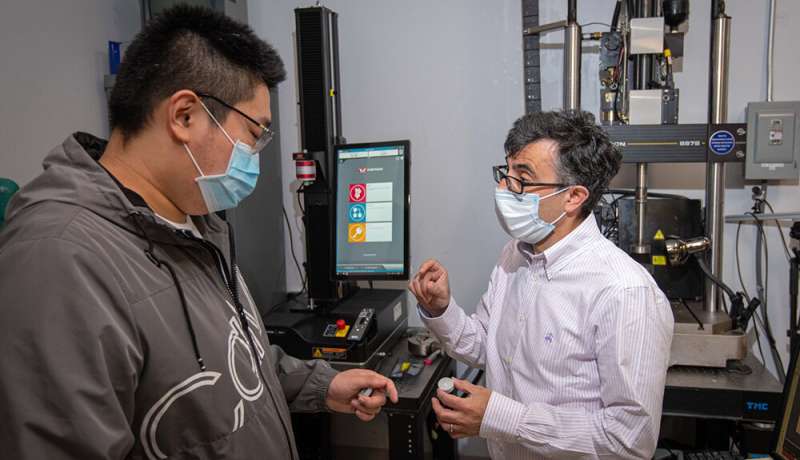Self-healing concrete could multiply lifespans of structures

Researchers at Worcester Polytechnic Institute (WPI) are using an enzyme found in red blood cells to create self-healing concrete that is four times more durable than traditional concrete, extending the life of concrete-based structures and eliminating the need for expensive repairs or replacements. The work, published in the peer-reviewed journal Applied Materials Today, uses an enzyme that automatically reacts with atmospheric carbon dioxide (CO2) to create calcium carbonate crystals, which mimic concrete in structure, strength, and other properties, and can fill cracks before they cause structural problems.
"The global use of concrete is ubiquitous," said Nima Rahbar, associate professor of Civil and Environmental Engineering and lead author of the paper. Concrete is the most widely used man-made building material in the world: it is a critical component in everything from bridges to high-rise buildings, family homes, sidewalks, and parking garages. But concrete is brittle and prone to cracking from exposure to water, thermal changes, stress, road salt, flaws in design, and other factors that can lead to a loss of structural integrity and the need for costly repairs or replacements.
"If tiny cracks could automatically be repaired when they first start, they won't turn into bigger problems that need repair or replacement. It sounds sci-fi, but it's a real solution to a significant problem in the construction industry."
Inspired by the process of CO2 transfer in nature, Rahbar's research, which previously received funding from the Massachusetts Clean Energy Center (MassCEC), uses carbonic anhydrase (CA), an enzyme found in red blood cells that quickly transfers CO2 from the cells to the blood stream. The CA enzyme, which is added to the concrete powder before it is mixed and poured, acts as a catalyst that causes atmospheric CO2 to create calcium carbonate crystals, whose matrix is similar to that of concrete. When a small crack forms in the enzymatic concrete, the enzyme inside the concrete connects with CO2 in the air, triggering the growth of a new matrix that fills in the crack.
"We looked to nature to find what triggers the fastest CO2 transfer, and that's the CA enzyme," said Rahbar, who has been researching self-healing concrete for five years. "Since enzymes in our bodies react amazingly quickly, they can be used as an efficient mechanism to repair and strengthen concrete structures."
The process, which Rahbar has patented, can heal millimeter-scale cracks within 24 hours.
The research paper, titled "An Enzymatic Self-Healing Cementitious Material," was published in Applied Materials Today, a peer-reviewed journal focused on cutting-edge applications of novel materials. Co-authors are Suzanne Scarlata, professor of Chemistry & Biochemistry; Jessica Rosewitz, former Ph.D. student and now an adjunct instructor of Engineering; and Ph.D. student Shuai Wang.
The team has developed a three-pronged approach that includes a concrete mix that, when used to build a structure, will autonomously mend small cracks that form; a mixture that can induce self-healing in larger cracks or holes; and a process that can be applied to traditional concrete to mend cracks.
To mend a bigger crack or hole, Rahbar said calcium and CO2 can be applied to spur autonomous healing. The same mixture can be used, but with a different application process, to initiate healing in already-set traditional concrete.
"Healing traditional concrete that's already in use is critically beneficial, too, and will help reduce the need to produce and ship additional concrete, which has a huge environmental impact," said Rahbar.
Concrete is a significant contributor to CO2 emissions, greenhouse gases that contribute to climate change. According to a 2018 report from the Chatham House, a policy institute headquartered in London, each year more than 4 billion tons of cement are produced, accounting for about 8 percent of global CO2 emissions. Extending its life could cut environmentally damaging CO2 emissions worldwide.
Researchers have long sought to develop processes to spur concrete to heal itself and keep small cracks from growing into larger cracks or holes to help the material retain its strength, water tightness, and durability. Rahbar predicts self-healing concrete could extend the life of a structure from 20 years, for example, to 80 years.
Other research into creating self-healing concrete has focused on adding microbes and Bacillus megaterium, a spore-forming bacteria that produces an enzyme that is expelled into the concrete mix. Rahbar opted to use enzymes directly instead of bacteria, noting that the bacteria are more expensive and work more slowly—taking up to a month to heal a 10-micron crack that the enzymes can heal in 24 hours—and there are concerns about potential long-term health issues related to their use.
More information: Jessica A. Rosewitz et al, An enzymatic self-healing cementitious material, Applied Materials Today (2021). DOI: 10.1016/j.apmt.2021.101035
Provided by Worcester Polytechnic Institute





















